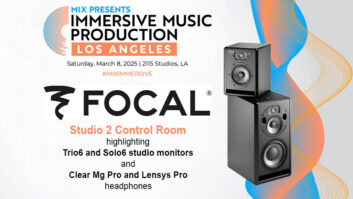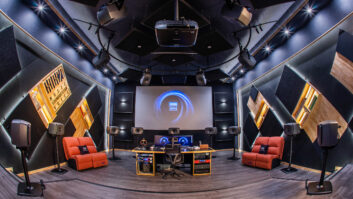One of the single most important decisions you will make in your career as an engineer will be your speakers. How they affect your work, someone’s performance and how they translate to every other listening space are all necessary considerations. Everything you do will be filtered through the quality (or lack thereof) of your monitors. So how to evaluate loudspeakers? Easy—start out knowing that there are an awful lot of ’em, and … wow, uh, why are there so many? The reason is that there’s no way there’s one that works for everybody or every situation or every source. At least with a reference with known faults, you can make reasonably informed decisions. Our METAlliance members all approach monitor analysis with similar methods to start, but individually reach their conclusions based on more than just tech and specs.
For George Massenburg, the first step is thinking about where, and to what, he wants to listen to most. For him, the easiest selection is picking a reference nearfield speaker in a control room, or any “controlled room”—one that’s large enough for reasonable low-frequency performance, is isolated and quiet, and has a good balance between absorption and diffusion. And it has to be comfortable. You’ll be in there for long periods of time and discomfort affects everything.
Related: Recording Legend Ed Cherney, Dead at 69, by Clive Young, Oct. 22, 2019
“It’s listening for all of the usual things, like a reasonably flat spectral response,” he says. “You might do a quick measurement with the Smaart Tools app on an iPhone, then listen for more obvious things: artifacts like a ‘spiky’ high end, peaky low end, the lack of the low octave on a source. We know we should have deep bottom, and ‘sparkle’ from a source having great high end. Listen both on- and off-axis too.”
He continues, “You might be impressed by ‘punchy’ low end, but just as quickly be dubious that you might be being hyped. We’ve all known that a great speaker will have a great ‘soundstage,’ but you should also be able to accurately identify localization cues between multiple monitors. A razor-sharp center image can give me the chills.”
Frank Filipetti will spend an hour or more listening to various aspects of monitors under consideration. Diffusion, diffraction, frequency response, transient response and transparency are all things he’ll consider, but he listens for something else as well. Like many of our METAlliance founders, he uses a reference song, James Taylor’s “Line ’Em Up” from the LP Hourglass. When he has a “holy s—” moment while listening, he reflects on what it was that he heard and considers why it affected him. For many years, he says, he listened to speakers (and microphones) just by how they sounded, not by how they affected him: “I had an epiphany one day where I realized that, just as in writing a song or producing a recording, the key word in choosing a speaker is ‘emotion.’ Nothing else matters, really.”
Al Schmitt says it this way: “Obviously, when listening for new speakers, I listen with my ears, but I also listen with my body. At first I focus with my ears, but then I get into the focus—how the speakers make me feel, what my bones feel like when I’m listening. Then it’s decision time. Do I like them enough to buy? Everyone hears differently, so you are your own judge.”
Related: The METAlliance Report: Critical Listening and Critical Evaluation, by George Massenburg, Jan. 30, 2019
Elliott Scheiner says something similar, sharing, “I can’t even remember how many times people have asked me, ‘What speakers do you use?’ The belief I concern myself with is ‘Beauty is in the eyes of the beholder.’ I have been through so many monitors over my life. Everybody’s ears are different. Whatever gives you the right balance and holds up on other systems is the one you should use. For me, I came across two monitors that worked, but always felt I had to try new ones as well. I would always come back to those two systems that always made the mix sound right. Just be concerned with what sounds right to you and the people you trust.”
Chuck Ainlay explains his most recent speaker decision-making process. “Over the years, my speaker needs have changed somewhat. I was pretty much a mercenary guy who would move from studio to studio, sometimes daily or even multiple studios daily. Back in those days, it was nice to see the ubiquitous white-coned woofer speaker in each studio. At least I had a reference I knew the faults of and could make reasonably informed decisions. I have never really loved working on those particular speakers, though, and I began a search for the speaker that would make my engineering life better. I’ve been through at least a dozen different nearfield monitors. Some were passive, some powered, and I can only say that there’s no such a thing as the ‘perfect’ speaker.”
Related: The METAlliance Report: Walk the Room, by Frank Filipetti, April 22, 2019
Ainlay adds, “All that being said, what I look for in a speaker is one that isn’t hyped, has low distortion, can generate high SPL levels without going into power limiting, and has decent low-end excursion. I now have speakers I’ve settled on, and at the moment, they seem to get me to mixes I’m happy with, that clients can listen to. We need to leave the studio confident that what they heard will translate to the real world.”
Importantly, his choice of testing environments is clear. “To find out if a speaker is going to satisfy all the criteria, you’ve got to test it while tracking, where you’ve got to make critical equalization decisions, and while mixing, where all the decisions you make must translate to a wide variety of playback environments. In other words, it takes a good bit of trial and error to know if a speaker suits your needs. Once you find a pair of speakers that works for you, stick with them. The more you understand what you are listening to, the better your work will be.”
A solid reference that meets the technical needs and gives you joy is one of the most valuable tools in your arsenal. Remember, you’ll be probably be staring at these things for a good portion of your everyday life!
METAlliance • www.metalliance.com
Want more stories like this? Subscribe to our newsletter and get it delivered right to your inbox.







